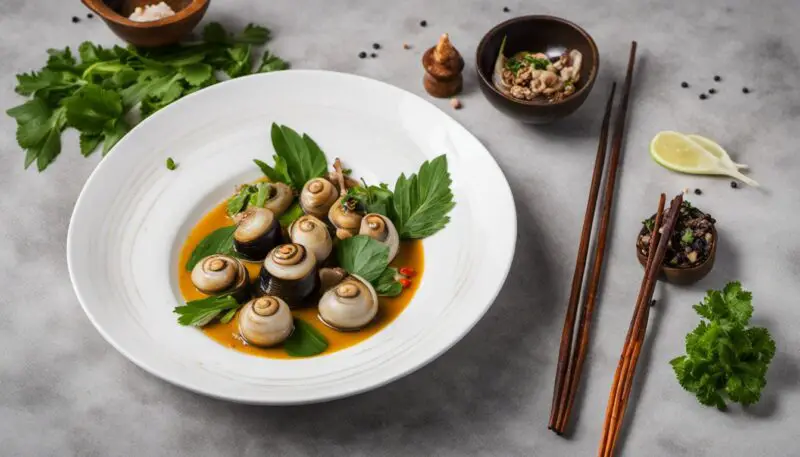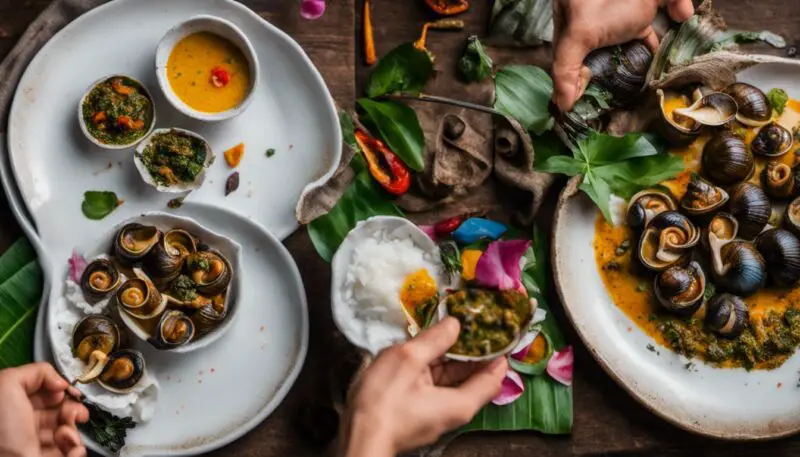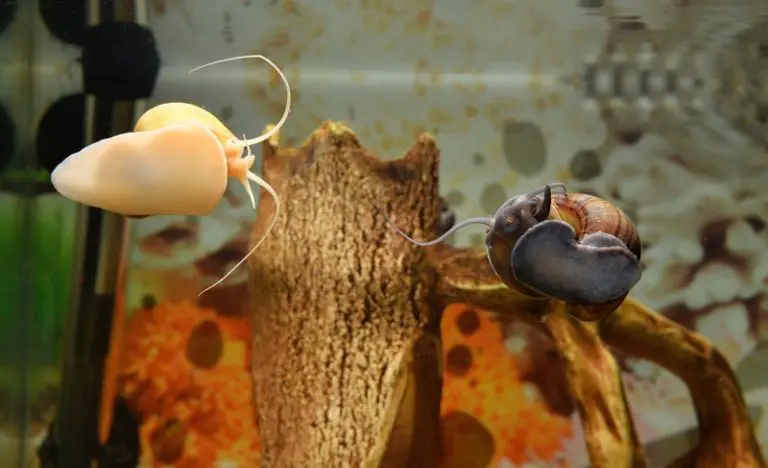Coconut Snails

Coconut snails are a unique and flavorful delicacy in Vietnamese cuisine, often served as an appetizer or a popular street food. These small sea snails are cooked in a rich, aromatic coconut sauce, creating an exciting and indulgent savory dish. As you explore the world of coconut snails, you’ll discover their versatility in various recipes and their cultural significance in Vietnam.

You’ll need fresh snails, grated coconuts, Vietnamese coriander, and other ingredients like garlic, butter, sugar, and fish sauce to prepare coconut snails. The key to achieving this dish’s perfect balance of flavors is extracting the first press of coconut milk from the grated coconuts. This process involves mixing the grated coconut with hot water, letting it sit for a few minutes, and squeezing the naturally rich and creamy coconut milk.
When cooking coconut snails, it’s essential to clean them properly and sauté them in garlic and butter before adding the coconut milk to create a delectable, thick sauce. This dish is best enjoyed with crusty bread, rice, or even a cold beer, as it is commonly served as a drinking food in Vietnam. As you savor the taste of coconut snails, you’ll appreciate the blend of unique flavors, textures, and culture they represent.
Contents
Table of Contents
Overview of Coconut Snails

Coconut snails are a type of shellfish that thrive in tropical marine environments. They can adapt to a temperature range between 24 and 27 degrees Celsius and need alkaline water with a pH greater than 7 for their shells to grow strong and healthy 1. These snails flourish in seawater, and it’s essential to maintain the salinity of the water between 1.020 and 1.025 when breeding them 2.
Their diet primarily consists of shellfish food, and they are sometimes known to consume some fish as well. Coconut snails are popular for aquarists, as they add an exotic appeal to their marine tanks 3. Sea snails, in general, are a favorite snack in many countries, including Vietnam, where they are often cooked in a coconut sauce and enjoyed as a street food delicacy 4.
Furthermore, these snails can be compared with other popular snails, such as apple snails. Apple snails are freshwater snails that also require alkaline water with a pH higher than 7 for the well-being of their shells 5. However, apple snails have different habitat and diet preferences, unlike coconut snails and are mostly found in ponds and aquariums.
In summary, if you’re interested in learning more about coconut snails, it is essential to understand their habitat, appropriate water conditions, and dietary requirements. As a unique species of sea snails, they offer an intriguing addition to marine environments and can be a fascinating subject of study for both aquarists and shellfish enthusiasts.
Nutritional Facts

When it comes to the nutritional content of coconut snails, you’ll find that they are quite a healthy option to include in your diet. Packed with protein, low in calories, and limited carbs, coconut snails can be a great choice for those looking to maintain a balanced diet.
One example of a coconut snail dish is Ginataang Suso (snail in coconut sauce). The nutritional information for this dish indicates that it contains 8 grams of carbs, 6 grams of sugar, and nearly no fat. This makes it a relatively low-calorie option while still providing essential nutrients.
Snails are a great protein source, comparable to pork and other meats. A typical serving of snails consists of 102 calories, 2 grams of fat, 57 milligrams of cholesterol, 79 milligrams of sodium, 2 grams of carbohydrates, and 18 grams of protein. Their high-protein content can help you build and maintain muscle mass, especially if incorporated into a balanced diet.
While snail meat alone is low in fat and calories, you should be mindful of how they are prepared. Cooking them in rich sauces or high-fat ingredients like coconut milk may alter their nutritional profile. To maximize their health benefits, consider choosing or preparing coconut snail dishes with minimal added fats or sugars.
In conclusion, coconut snails can be a nutritious, protein-packed addition to your diet. However, be conscious of the method of preparation and the additional ingredients used to ensure you’re getting the most nutritional benefits possible.
Cleaning and Prep

Cleaning coconut snails might seem daunting, but it can be a breeze with the right tools and steps. Start by gathering a toothpick, a brush, and a large bowl full of fresh water. These will assist you in properly cleaning and preparing the snails for cooking.
First, use the toothpick to gently remove any debris or dirt stuck in the crevices of the snail’s shell. Be meticulous, carefully examining each groove and indentation. This process will eliminate any loose particles that could affect the taste or quality of your dish.
Next, take the brush and gently scrub the exterior of the snail’s shell. This will help remove any remaining dirt, moss, or algae that may be present. A brush with sturdy bristles is recommended, as it provides enough friction to remove stubborn particles while gentle on the shell.
After scrubbing, place the snails in a bowl of fresh water, ensuring they are entirely submerged. Allow them to soak for about 10 minutes, giving them time to release any inner wastes or residue. It is normal to see bubbles or movement during this process as the snails release their waste.
Once the soaking time has elapsed, use a strainer or slotted spoon to remove the snails from the water. Rinse them thoroughly under cool running water, paying close attention to the shell’s openings to remove any lingering residue. This will ensure that your snails are clean, both inside and out.
Now that your snails are cleaned and prepped, you can confidently move forward with your favorite coconut snail recipe. By following these steps, you ensure that the final dish will be of the highest quality, free of any unwanted dirt or particles.
Basic Cooking Guidelines

When cooking snails, especially coconut ones, it’s important to follow some basic guidelines to ensure a delicious and well-prepared dish. In the next few paragraphs, you’ll find detailed steps to clean, prepare, and cook coconut snails while taking note of the required prep and cook time.
First, before starting the cooking process, you must thoroughly clean the snails. Hold two or three snails and rub them in your hands to remove any dirt or debris. Rinse them well under running water and repeat the process until all snails are cleaned source.
Prep Time: 20 minutes
Cook Time: 25 minutes
Total Time: 45 minutes
Once the snails are clean, the next step is to prepare them for cooking by boiling them. Place the snails in a pot filled with water and boil them for about 3 minutes. After boiling, drain and rinse them with plenty of cold water to remove any remaining mucus source.
Now that the snails are clean and partially cooked, you can create a delicious dish. One popular option is to cook coconut snails in coconut milk. To prepare this dish, you’ll need the following ingredients:
- 1 lb cone-shaped escargot/mud creepers
- 2 tablespoons vegetable/coconut oil
- 1 tablespoon minced garlic
- 2 tablespoons minced lemongrass
- 1 14-oz can coconut milk
- 1/3 cup water
- 1 teaspoon salt
- 1 teaspoon sugar
Start by heating oil in a pan and sautéing the garlic and lemongrass until fragrant. Add the cleaned snails to the pan and stir-fry them for a few minutes. Next, pour in the coconut milk, water, salt, and sugar. Bring the mixture to a boil, then reduce the heat and let it simmer for about 20 minutes or until the sauce has thickened source.
Remember, following these basic cooking guidelines will result in a flavorful and tender coconut snail dish. Enjoy your cooking adventure!
Sea Snails in Coconut Milk (Ốc Len Xào Dừa)
Traditional Filipino Ginataang Kuhol Recipe
Ginataang Kuhol is a classic Filipino recipe with apple snails cooked in a rich coconut milk sauce. The dish is well-loved for its creamy and mildly spicy taste. In this section, you’ll find a simple yet delicious recipe to prepare this traditional Filipino dish at home.
To begin with, make sure to gather all the necessary ingredients for the Ginataang Kuhol recipe. You will need the following:
- 1 lb. apple snails (Kuhl)
- 2 cups coconut milk
- 2 tablespoons bagoong (shrimp paste)
- 2 tablespoons cooking oil
- 1 medium onion, sliced
- 3 cloves garlic, minced
- 1 1/2 inch piece of ginger, thinly sliced
- 4 green chili peppers (siling pangsigang)
- Salt, sugar, and pepper to taste
Start by thoroughly washing and scrubbing the apple snails to remove dirt or debris. Next, heat the cooking oil in a pan, sauté the garlic until golden brown, and add the ginger and onions. Cook until they become soft and fragrant. Then, stir in the bagoong and cook until everything is well-blended.
Add the apple snails to the pan, followed by the coconut milk. Cover the pan tightly, and let the mixture cook over low heat, allowing the snails to become tender and absorb the flavors of the sauce. This may take around 30 to 40 minutes.
During the cooking process, you may need to adjust the seasoning by adding a little salt, sugar, or pepper according to your preference. Finally, add the green chili peppers, and let the dish simmer for a few minutes more until the coconut milk thickens and the sauce reaches your desired consistency.
Serve the Ginataang Kuhol hot with steamed rice and enjoy this traditional Filipino dish’s rich, creamy, and comforting flavors.
Vietnamese Coconut Snail Dish – OC Len Xao Dua

If you’re exploring Vietnamese cuisine, you must try the authentic street food dish called Ốc Len Xào Dừa, or sea snails in coconut milk. This flavorful dish is a specialty of Ho Chi Minh City, also known as Saigon and incorporates a variety of fresh ingredients and spices.
To make Ốc Len Xào Dừa, first, you’ll need fresh mud creeper sea snails or other types of sea snails. The dish is infused with flavors from diverse ingredients, such as lemongrass, chili peppers, garlic, and Vietnamese coriander, also known as rau ram. Additionally, you will need shrimp paste and fish sauce to elevate the taste.
Start by cooking the sea snails in coconut milk and lemongrass. Incorporate minced garlic and shrimp paste and let them simmer until they turn fragrant. To bring a bit of heat, add thinly sliced chili peppers.
While the sea snails are cooking, you can prepare the sauce. Combine fish sauce, sugar, and pepper, then pour the mixture over the snails, letting them soak up those flavors. Finally, add butter and some finely chopped Vietnamese coriander and cook until the sauce thickens.
Ốc Len Xào Dừa is typically served with hot steamed rice, allowing you to enjoy the rich and creamy sauce with each bite. This dish packs a flavorful punch, and its unique combination of ingredients highlights the diverse, exciting world of Vietnamese street food.
So when you have the opportunity, be sure to try Ốc Len Xào Dừa and indulge in the complex flavors of this delicacy—it’s an experience you won’t forget!
Chinese Coconut Snail Dishes

Chinese cuisine offers a variety of delectable seafood dishes, and one such popular choice is the coconut snail dish. These dishes feature mud creepers, a type of sea snail, that are sautéed in flavorful sauces, creating an exquisite dining experience. This section will explore a popular Cantonese-style coconut snail dish you can prepare and enjoy at home.
Cantonese-Style Periwinkle Snails in Black Bean Sauce: This dish showcases the delicious combination of snails and black bean sauce. The first step in preparing the dish involves boiling the snails, which can be done by covering them in cold water and bringing them to a boil for 10 minutes. Once cooked, drain the snails and rinse them in cold water.
Next, create a flavorsome base for your dish by heating oil in a large wok or pan over medium heat. Add ginger, chopped garlic, and onion to the oil and allow them to infuse for about 10 seconds. Then, stir in ground black bean and garlic sauce. The use of black bean sauce adds depth of flavor and complements the tender texture of the snails.
To further enhance the taste, add a dash of turmeric which lends a delicate earthy flavor and a vibrant color to the dish. Now, it’s time to incorporate some healthy greens! Add spinach to the wok and cook until wilted. Spinach brings a welcome pop of color and adds essential nutrients to the meal.
As this dish simmers, prepare a bed of steaming hot rice to serve it with. This helps soak up the rich sauce and creates a perfect accompaniment to the snails. Mix in some diced tomatoes as a garnish just before serving to add freshness and contrast in flavor and texture.
With these steps, you can easily prepare a delicious Chinese coconut snail dish that showcases a tantalizing blend of flavors. Enjoy it as a main course alongside a bowl of steamed rice, or relish it as a flavorful appetizer in your seafood feast.
Social Media Influence on Coconut Snail Cuisine

Due to the increasing popularity of food-related content on platforms like Instagram, coconut snail dishes have gained more attention and recognition worldwide. As people share their culinary experiences, you might have seen tantalizing images of dishes like Vietnamese Sea Snails in Coconut Milk (Ốc Len Xào Dừa) on your social media feeds.
The dishes often feature vibrant colors, distinct flavors, and a unique combination of ingredients, making them visually appealing and instagrammable. As a result, food enthusiasts, bloggers, and influencers are more likely to share their coconut snail dishes on social media platforms, sparking curiosity and interest among a broader audience.
Some popular coconut snail dishes worth trying include:
- Ốc Len Xào Dừa, which consists of mud creepers sauteed in a thick, savory, and aromatic coconut sauce.
- Snail noodles, or luosifen, are a Chinese dish that pairs slippery noodles with a flavorful snail-based broth.
As the popularity of coconut snail cuisine continues to grow, you can expect to see these dishes featured more frequently on restaurant menus and food delivery apps. This increased exposure generates more opportunities to taste and appreciate the unique combination of flavors found in coconut snail dishes.
The social media buzz also encourages you to experiment with different cooking styles and techniques in your kitchen, helping you express your creativity and master your culinary skills.
Frequently Asked Questions
What is the nutritional value of coconut snails?
Coconut snails are a good source of protein and contain essential minerals like iron, magnesium, and calcium. They are relatively low in fat and carbohydrates, making them a healthy choice for people looking to watch their calorie intake. Remember that the nutritional value may vary depending on the cooking method and recipe used.
How are coconut snails prepared in Vietnamese cuisine?
In Vietnamese cuisine, coconut snails are often cooked in a delicious conut milk-based sauce that imparts a unique flavor to the dish. The snails are first cleaned and boiled before being cooked with aromatic ingredients like garlic, lemongrass, chili, and fresh herbs. This dish, known as Ốc len xào dừa, is enjoyed as a flavorful appetizer or paired with steamed rice for a satisfying meal.
Where can I find Ốc len xào dừa near me?
To find a restaurant or eatery serving Ốc len xào dừa near you, try searching on popular food platforms such as Yelp, Google Maps, or other local food directories. Look for Vietnamese restaurants or local eateries that specialize in Southeast Asian cuisine, as these are more likely to offer this delicious coconut snail dish.
Are there any known health benefits or risks associated with consuming coconut snails?
Like other shellfish, coconut snails are a good source of high-quality protein and essential minerals. However, if you have a shellfish allergy or existing health condition, it’s always best to consult your doctor to confirm whether consuming coconut snails is safe. Also, proper food handling and preparation are crucial to reduce the risk of foodborne illnesses when consuming shellfish, including coconut snails.
What are some popular dishes featuring coconut snails?
In addition to Ốc len xào dừa, coconut snails can be prepared in various ways, depending on the cuisine and regional preferences. Some popular dishes featuring coconut snails include snail curry, grilled snails with herbs and spices, and snail salads. The versatility of coconut snails allows for a variety of delicious recipes that showcase their unique flavor and texture.
Is there a difference between escargot and coconut snails in terms of taste or texture?
Escargot refers to edible land snails, typically from the species Helix pomatia, whereas coconut snails are marine mollusks, often belonging to the Terebridae family. While both are consumed as delicacies worldwide, the taste and texture of escargot and coconut snails differ. Escargot is known for its tender texture and mild flavor, while coconut snails have a firmer texture and a slightly sweet taste that complements the rich sauces they’re typically cooked in. Each snail type offers a unique culinary experience to be enjoyed by gastronomes and adventurous eaters alike.



![What Do Zebra Snails Eat? [Full Guide]](https://allourcreatures.com/wp-content/uploads/2021/10/bigstock-Spotted-Nerite-Snail-neritina-402430379.jpg)
![Do Snails Eat Grass? [Complete Answer]](https://allourcreatures.com/wp-content/uploads/2021/10/snails-eat-grass-768x519.jpg)

